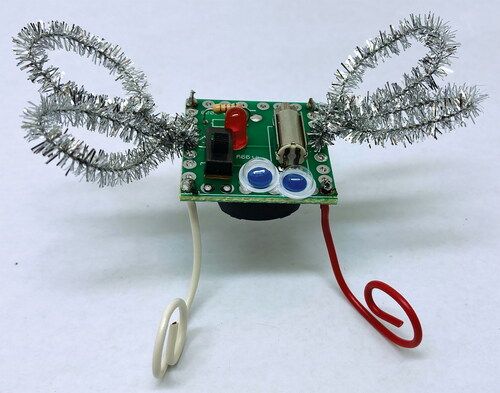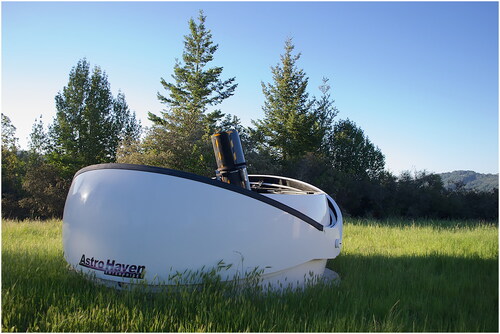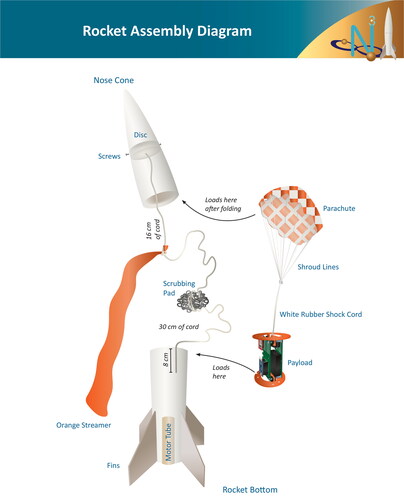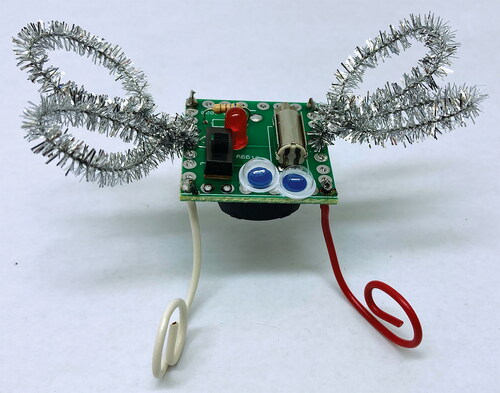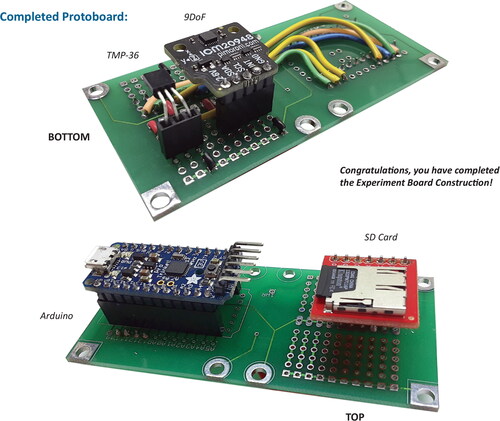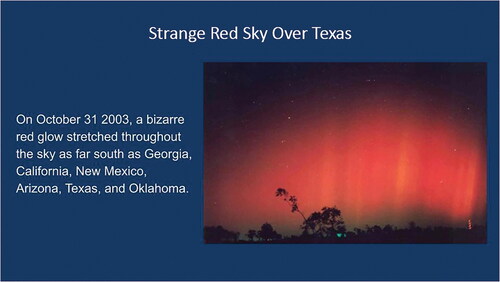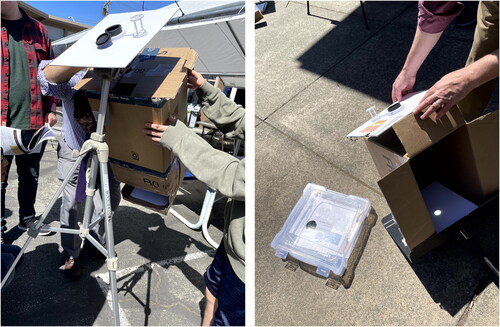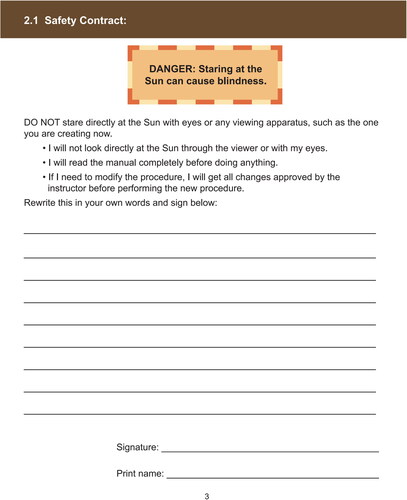Abstract
We live in a neurodiverse world, and therefore need to ensure that equally diverse educational opportunities are accessible to all learners. The term neurodiversity, coined by Judith Singer (Citation1999) describes the broad, and complex, spectrum of human brain functionality. Terms like neurodivergent or neurodistinct (Goldstein Citation2020) include a wide range of neurotypes (such as autism, ADHD, ADD, dyslexia, dysgraphia and others). These neurotypes may present with challenging characteristics such as sensory issues, difficulty with executive function, or intense focus on specific interests. However, some of these characteristics can also be strengths when learners are understood, supported, and valued. Informal learning settings can be especially supportive environments for neurodivergent learners because there are often fewer time constraints for accomplishing tasks, activities are frequently hands-on and visual, learners are able to move about the space as they wish, and they can pursue activities in which they are most interested. Many kinds of learners can benefit from settings with these qualities, but they are particularly beneficial for those with sensory, attention, and social difficulties, which neurodivergent people often have. This is why understanding how to make connections between informal and formal education environments is so important for educators seeking to create educational opportunities that are accessible to a broad and neurodiverse learner population.
A central tenet of the neurodiversity movement is the idea that nothing should be designed for neurodivergent populations without the involvement of members of that community (Fletcher-Watson et al. Citation2019). An important aspect of Universal Design for Learning (UDL) is that everyone benefits when educational materials and experiences are designed to support learners who have been marginalized, such as those with disabilities or differences (CAST Citation2023). Rather than designing a single format in which the information is given to the learner, we endeavor to offer as many unique ways to absorb information as possible. This includes images, digital or printed handouts, videos, hands-on instructions, graphic organizers, and visual schedules. NASA’s Neurodiversity Network, or N3, builds on these ideas by collaborating with both neurodivergent young people, particularly those on the autism spectrum, and teachers who work with them to develop challenging STEM programs that can be integrated into formal or informal educational settings to inspire youth to pursue STEM careers.
N3 was funded by NASA to make STEM education—particularly informal STEM education—more accessible to populations underrepresented in STEM education and workforces. N3 was inspired by Professor Lynn Cominsky’s work with an autistic student in her community, Alex, who started an informal project in the Sonoma State University lab at age 18. Cominsky fostered Alex’s interests in astronomy and physics, and Alex showed tremendous growth, not only in his academics, but in his self-efficacy regarding socializing and communicating ideas. Alex is currently pursuing a graduate degree in physics. Now in its fourth year, N3 has provided STEM learning opportunities for hundreds of neurodivergent learners through STEM programs in formal and informal education settings as well as summer internships mentored by NASA subject matter experts. Through this experience our team has learned a great deal about how to support the needs, interests, and strengths of neurodivergent students, and many of these adaptations can be beneficial to a wide range of learners.
Key lessons and design principles we learned from this work agree with those found in a synthesis of research for effective strategies in science education for autistic learners (Barnett, Frankel, and Fisher Citation2018) and include:
Provide a meaningful story or context for the content. STEM content is often presented to learners independent of its purpose and real-world relevance. Such disconnections can be problematic for many learners, but they make it almost impossible for learners with challenges in attention and focus. Having a personally relevant reason to learn is necessary for making STEM content accessible for many learners.
Offer a range of options for interacting, expressing ideas, and engaging in the work. A core UDL principle—having options for how to engage with material—is essential for populations as heterogeneous as neurodivergent learners. This entails employing various media (such as images, audio, video, text, hands-on activities) for conveying information in many ways, as well as how learners share what they have learned. It also means paying attention to sensory, attention, and social preferences when designing the learning environment and implementing the experiences. The preferences will vary by learner: there is no single design or activity choice that works for all learners, which is why having options is essential.
Build on strengths and interests. So often efforts to make resources and experiences accessible focus on how to mitigate learner challenges, rather than adapting the resources to meet existing interests. As Patten Koenig (Citation2020) writes, “No one, however, builds their lives on remediated weaknesses. We build our lives on things we do well, and our interests.” Many learners, and especially many neurodivergent learners, have deep and abiding interests that they often do not get to pursue in educational settings. Informal STEM experiences can provide an opportunity for learners to follow their interests and enable educators, peers, and the neurodivergent learners themselves to see what they are capable of when deeply engaged (Martin et al. Citation2020). Educators can build on that engagement by making connections to formal STEM content.
Listen, observe, learn, adapt. As with each of these lessons, this can apply to any learner, but it can make all the difference for neurodivergent learners. Throughout this project we have been privileged to work with highly skilled educators who know their students deeply and understand how to help them thrive, and to work with an amazing group of learners who know how to advocate for themselves. There is no specific set of designs, recommendations, or methods that works for all learners other than learning from them by listening to their feedback; observing what causes frustration, disengagement, interest, discovery and joy; and adapting the experience to support the latter. Adaptability equals accessibility.
Designing the high school space science curricula
We used an iterative, collaborative design process (known as “co-design”) to create three space science curricula with neurodivergent students and their teachers that can be implemented either as an informal program or integrated into formal science instruction. One aspect of a respectful co-design process is to compensate teachers and students for their time. N3 hired teachers and provided students with stipends for their participation in the co-design process.
The Astronomy Anywhere curriculum focused on an existing NASA resource, Astronomy from Home, where students learn how to access, gather, and interpret real astronomical data using the Sonoma State University–owned Gamma-ray Optical Robotic Telescope (GORT; ). The Rocketry curriculum has students build and launch their own rocket, learn to solder a payload for collecting data, and analyze the data gathered from their rocket launch. The Solar Science curriculum focuses on understanding solar cycles and how solar electromagnetic activity affects systems on Earth.
The development of these three curricula follows an iterative process:
Project staff select existing NASA educational resources/programs that would appeal to high school students based on both a survey conducted in Year 1 and input from our teacher and student partners.
Project staff meet with educators who teach science in high schools that serve neurodivergent youth. Project staff train the educators on the scientific and technical aspects of the materials and discuss with teachers how they could adapt the program based on student needs and their educational context. Educators also provide feedback on our initial curriculum, which is then incorporated into what is created to use with students.
The educators adapt the program materials and implementation process for their students and contexts and implement the curriculum in either a formal or informal setting.
During implementation, project team members and evaluators visit the schools to understand the context of each implementation setting.
After implementation, project staff meet for 8–10 hours (spread across multiple days) over Zoom with each co-design teacher and 1–3 of their students to walk through the full curriculum. The students provide detailed feedback on what they enjoyed; what they found challenging; and what they would change, add, or extend in each of the lessons and for the overall program. Teachers tell us what they did differently from the draft curriculum and share any revised or additional materials they used.
Evaluators conduct interviews with co-design teachers and students to gather feedback on the whole process.
Project staff revise the materials based on feedback and share the revised curricula with the educators for final review.
Below we share what we learned from our teacher and student partners and how we are adapting the curricula in relation to the design principles described above.
Provide a meaningful context for the content
Our first curriculum, Astronomy Anywhere, explores how NASA scientists learn about space from the data they collect through telescopes. The curriculum draws upon an existing NASA resource called Astronomy from Home, designed to enable learners to access and request observational data from GORT, a remote robotic telescope, and learn how to analyze data to produce scientifically accurate results. Project staff also selected other activities and materials related to telescopes, optics, how the eye works, and how to interpret color and brightness data to help learners understand the science behind the images they would be receiving through the remote telescope. There were also activities in the program related to exoplanets and variable stars that required learners to use repeated measurements to see changes in light over time to draw conclusions about the phenomena.
The curriculum was organized into five lessons, each with its own theme:
Understanding Images
Acquiring Images from Robotic Telescopes Remotely
Making a Color Image
Measuring Brightness in Images
Variability and What We Can Learn from It
Each of these lessons had a mixture of lecture, hands-on activities, and visuals. Some also had a good deal of computer work, including analyzing images and collecting and interpreting data.
The program was implemented in four high schools in various ways, sometimes all day for five straight days, sometimes as part of a summer course or informal camp across many weeks. Students successfully completed the program and both students and teachers reported many positive experiences with the content and activities. “Students loved enhancing images,” said one teacher, “It was probably the highlight of the class for them.” Teachers and students also had lots of suggestions for how to improve the materials. For example, using more visuals to convey challenging concepts, such as how color relates to the size and temperature of stars.
However, across all the school sites we consistently heard that the curriculum needed a guiding story so that students could see the purpose for learning all the content and engaging in the various activities. One teacher told us, “The only challenge I faced is that we had a lot of data collection and I like to have a story behind the data as to why we’re doing it.” Though students could have enjoyable experiences with different aspects of the program, the teachers and students felt that they did not necessarily see how all the different pieces fit together without an overarching narrative. Some suggestions for this narrative included
investigate whether we are alone in the universe and how we can search for inhabitable planets and
explore our cosmic address and where we are in relation to other objects in the universe.
Project staff made many revisions to the Astronomy Anywhere curriculum, including providing meaningful contexts for organizing all the sessions and activities. A teacher described how he appreciated the collaborative development of the curriculum.
The biggest success of the redesign process was actually talking with [N3 staff member] and really trying to figure out the larger goals, and how to tie the individual activities to those larger goals…giving the students the larger picture, so they understood where this particular activity changed, and the larger scope of space, and space understanding and exploration, that was most helpful. So I knew what seems to really prepare the kids for, and the language to use with them, so that they could not see these as eight separate classes, but as one cohesive unit that we were passing through.
Offer a range of options for interacting, expressing ideas and engaging in the work
The Rocketry curriculum focused on building a rocket and payload, launching the rocket, and learning from the data collected from the payload instrumentation. The curriculum was based on a previous NASA program, Rising Data, originally created for underrepresented community college students, and was quite technically challenging. The program took the students through a step-by-step process of building a rocket from a kit (), learning how to solder electronics by creating a simple circuit board creature called a Jiggybot (), and then creating a rocket payload by soldering a number of different sensors (e.g., temperature, motion) onto a breadboard and testing them on a computer to see if they work (). The students then launched the rockets () with the help of a rocketry expert, retrieved the payload after the launch, and analyzed the data collected by the instruments.
Although quite time and labor intensive, this program was very popular with both students and teachers because it helped them see that they could tackle challenging problems and they were trusted with sophisticated tools and electrical components. When asked what benefits the program may have had for students, one teacher replied,
Confidence was a big one. Soldering and electronics feels very intimidating. Once you know how it works, that confidence is just immeasurable. They just loved that…. if I had to pick the most valuable thing they got out of this, is they got confidence that they too could one day be a rocket scientist.
However, there were many aspects of this program that needed to be revised to make it accessible to neurodivergent high school populations. First, the program guide provided too much information in text alone on each page and marched all students through the same step-by-step process with the same tasks to complete in the same amount of time. The project team created videos of the assembly, but they covered the whole process rather than short segments of specific steps. This format did not account for variability in learning preferences; sensory issues with the soldering tool; or fine motor challenges related to handling tiny wires, solder, and electrical components. When asked what adaptations a teacher made to the program, he replied:
It was largely a matter of making sure that everything gets explained in multiple manners. I am going to tell you this, and I'm also going to show you this. I'm also going to demonstrate this. All three of those happen before it gets started, with you doing it. I feel like that is the key component there, in terms of how this was implemented. We didn’t ask any less of the students. We just made sure that everything was explained in a more thorough and more adapted manner for them.
Build on strengths and interests
The Solar Science curriculum that we created was focused on understanding how the Sun works and how solar events such as coronal mass ejections can have significant impacts on Earth. The curriculum is broken up into five sections:
Mysteries
Engineering a Sunspotter
NASA Observes the Sun
A Stormy Sun
Living with a Star
At the start of the program the students are presented with a series of mysterious events, such as satellites malfunctioning, the Aurora Borealis being seen much farther south than normal, and large-scale power outages (). They are asked to come up with a hypothesis for what might have caused these events and start searching websites for data that might support or refute those hypotheses. Engineering a Sunspotter has students build a sunspotter that they can then use to collect data each day tracking sunspots and observing how they move and change (). Anytime students are working in science, there are safety precautions that need to be followed. For each curriculum, there were topic-appropriate safety contracts included in the student guides. For example, shows an eye safety contract. In NASA Observes the Sun, students learn about the layers of the Sun and eclipses, and are introduced to the student version of Helioviewer, the web-based tool NASA uses to display sunspots and other data about the Sun. In this lesson, students compare their sunspot recordings to those from different NASA satellites. In the next two sessions students learn more about the Sun’s electromagnetic activity and geomagnetic storms and use Helioviewer data from previous years to investigate solar conditions when the mysterious events took place.
The curriculum came with slide decks, the mysteries handouts, materials for building the sunspotter, and a wide range of other possible activities and resources that teachers could use. Materials included an activity using magnets to illustrate the Earth’s magnetic field and a series of Sun fact cards that students could flip through, with empty cards on which they could add their own facts. At this point, the teachers were in their third year of working with our team, so they knew that we encouraged them to implement the curriculum however they felt was best for their students. They knew their students’ strengths and interests, so each program was informed by what their students wanted to pursue, and as such was different from the others. As one teacher said, “If you see a student engage with something, see what else you can do to build on that.”
Two teachers who knew their students liked design challenges brought in extra cardboard boxes and encouraged them to use materials around the school to build their sunspotter. When one student hypothesized that the mysteries might be caused by aliens, the teacher encouraged him to investigate what NASA is doing to explore the potential of life beyond our solar system. While aliens were not the answer, he was able to follow that interest to find disconfirming evidence. A student who was interested in science facts loved the Sun facts cards. “Towards the end,” said the student, “I started using those empty fact cards, and I put some stuff about the Sun on it. I made sure I had a good understanding of it.” Some students became very interested in the monocular—a component of the sunspotter. Their teacher told us:
Before we mounted the sunspotter on the tripod, [they] took [the monocular] outside into our environment. We had this nice environment, so there’s lots to observe. My students spent about three hours just looking through the monocular, never at the Sun. [They] knew not to look at the sun with it. I think that was important for them to have that time just to manipulate the object and look through it before we start actually using it more formally.
Listen, observe, learn, adapt
The program we describe here was a collaboration among scientists, program developers, researchers, educators, and youth. The goal was to co-design a series of challenging space science curricula for formal or informal implementation by
drawing on existing NASA educational resources and
listening, observing, and learning how to adapt them with and for neurodivergent youth with many differences, strengths, and interests.
Since this work was funded through a five-year grant, we understand the full design process we used likely cannot be replicated in many typical educational settings on a regular basis. However, there are practical lessons that program developers and educators can take from our work about how to ensure that educational experiences are accessible and engaging for a wide range of neurodivergent young people.
One lesson is that, if given the opportunity, participating in informal programs can serve as low-stakes professional learning experiences that enable educators to gain content as well as pedagogical knowledge. When asked what he would tell other teachers about the benefits of engaging in this kind of informal learning experience, one teacher said, “Don’t worry about having to know all of the content yourself at first and give yourself permission to learn along with your students and to learn along with the co-design team.” This openness to listen, observe, and learn can increase educators’ understanding of the strengths and preferences of their neurodivergent students in ways that formal education settings, with their time constraints and demands for content coverage, rarely allow. It is also empowering for youth to be able to teach their teachers, and instructive for youth to see their teachers learning and growing.
Another lesson is that informal learning experiences can give educators the time to try challenging activities with young people, see what works well, and, for those educators who work in both settings, bring that back to their formal instruction. One teacher reflected on the program,
I think I learned or was reminded of different means of engagement, ways to make things more engaging for students. Every N3 summer program that I do, I remind myself I need to do more of this during the school year, more of these hands-on, project-based learning activities.
Many educators know that things like hands-on activities, providing a meaningful context, and having multiple ways to engage with content and express ideas can be more engaging for a wide range of students, particularly neurodivergent students. However, they rarely have the time to work through how to integrate them in formal instruction. Informal programs allow educators to test things out and practice how to organize materials, practice timing, and iron out other components of those adaptations before using them during formal instruction.
The third lesson for curriculum development is how essential it is to involve educators and youth in the design process. Our team learned an enormous amount from our co-design partners (both learners and educators) by encouraging them to think creatively about
implementing the educational materials in a variety of formats,
supporting them to fully implement those programs,
listening to and observing what their experiences were, and
learning how to adapt the curricula based on those experiences.
The co-design process offered the time and space to slow down, reflect, and amplify a diverse set of voices and perspectives. This was a win-win for youth, educators, and curriculum developers. For educators, this reflective process was an opportunity to enhance their pedagogical knowledge in anticipating student struggles and planning for them. As one educator shared:
The biggest success is having so many people discussing things. We were able to anticipate a lot of issues that might arise…Having that kind of open space where we could brainstorm workarounds for these foreseeable struggles was really helpful, and to develop some language communally to address them was really, really helpful.
Conclusion
Neurodivergent people are highly capable of engaging in challenging educational programming. Those who happen to have interests that align with traditional school subjects (for example math, history, music) may thrive in typical school environments. However, many more could be thriving if learning experiences and materials were adapted to address the sensory, attention, and social challenges some youth may have, and that build on their many strengths and interests. The full range of differences, preferences, and capabilities of students across all neurotypes can only be understood by spending time with them, engaging with them, and learning from them. While this can be difficult during formal instruction, informal programming offers educators the opportunity to try out various activities, media formats, and topics and get to know their students when there are fewer pressures or requirements. By being intentional about building connections across informal and formal contexts—whether by having teachers work with students in after school clubs, summer programs, or even enrichment days—educators can learn how to create meaningful experiences that can benefit all students.
Author note
Throughout this article we use identity-first language (i.e., autistic person) rather than person-first language (person with autism) because that is generally preferred by individuals in the autism community (Gernsbacher Citation2017; Kenny et al. Citation2016; Taboas et al. Citation2023).
Disclosure statement
No potential conflict of interest was reported by the authors.
Data availability statement
The authors confirm that the data supporting the findings of this study are available within the article [and/or] its supplementary materials.
References
- Barnett, J. H., A. J. Frankel, and K. W. Fisher. 2018. “Systematic Review of Evidence-Based Interventions in Science for Students with Autism Spectrum Disorders.” Education and Training in Autism and Developmental Disabilities 53 (2): 128–145.
- CAST. 2023, October 16. The UDL guidelines. https://udlguidelines.cast.org/
- Fletcher-Watson, S., J. Adams, K. Brook, T. Charman, L. Crane, J. Cusack, S. Leekam, D. Milton, J. R. Parr, and E. Pellicano. 2019. “Making the Future Together: Shaping Autism Research through Meaningful Participation.” Autism: The International Journal of Research and Practice 23 (4): 943–953.
- Gernsbacher, M. A. 2017. “Editorial Perspective: The Use of Person-First Language in Scholarly Writing May Accentuate Stigma.” Journal of Child Psychology and Psychiatry, and Allied Disciplines 58 (7): 859–861.
- Goldstein, T. 2020. Neuro Cloud, Neurodistinct, Neurodiversity Refined. An Explanation Why. https://www.timgoldstein.com/blog/neurodiversityrefined
- Kenny, L., C. Hattersley, B. Molins, C. Buckley, C. Povey, and E. Pellicano. 2016. “Which Terms Should Be Used to Describe Autism? Perspectives from the UK Autism Community.” Autism: The International Journal of Research and Practice 20 (4): 442–462.
- Martin, W. B., J. Yu, X. Wei, R. Vidiksis, K. K. Patten, and A. Riccio. 2020. “Promoting Science, Technology, and Engineering Self-Efficacy and Knowledge for All with an Autism Inclusion Maker Program.” Frontiers in Education 5. https://doi.org/10.3389/feduc.2020.00075
- Patten Koenig, K. 2020. “Authentic Strength-Based Practice: Can Neurotypical Professionals Make a Paradigm Shift?” Autism Spectrum News, Winter. https://autismspectrumnews.org/authentic-strength-based-practice-can-neurotypical-professionals-make-a-paradigm-shift/
- Singer, J. 1999. “Why Can’t You Be Normal for Once in Your Life?: From a ‘Problem with No Name’ to a New Category of Disability.” In M. Corker and S. French (Eds.), Disability Discourse. UK: Open University Press.
- Taboas, A., K. Doepke, and C. Zimmerman. 2023. “Preferences for Identity-First versus Person-First Language in a US Sample of Autism Stakeholders.” Autism: The International Journal of Research and Practice 27 (2): 565–570.

